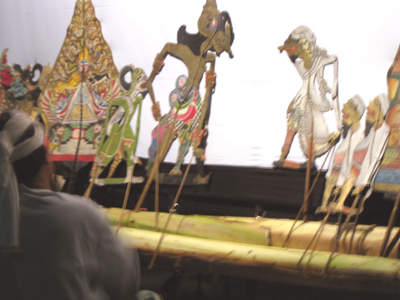Munarsih Sahana , Contributor , Yogyakarta | Fri, 09/18/2009 1:07 PM | Lifestyle
Pesindhen, the Javanese female singers who sit in a line facing the puppet master, are a traditional part of wayang kulit (leather puppet) shows. But they were notably absent from the wayang sambung performed at Yogyakarta's Gadjah Mada University last week.
Instead, all the singers and musicians were men wearing Islamic shirts, known locally as baju koko, and Islamic headdresses.
Ki Muhammad Mukti, the puppeteer, wore a special white headdress similar to those worn by Islamic preachers. He told the story of Bima disseminating knowledge about Islam, with the establishment of Makrifat Jati Islamic boarding school, where people could deepen their knowledge about the Koran.
Ki Mukti said it would be complicated to have female singers as, apparently, love affairs between puppeteers and their female singers are common in the world of this performing art. For example, a puppeteer from Central Java who performed in Yogyakarta earlier this month said he had a total of 13 children from five different wives, all of who were pesindhen.
Ki Mukti, a lecturer at Yogyakarta State University and a doctoral candidate at the Gadjah Mada University's School of Philosophy, performed a special puppet show for Islamic preaching.
 Islamic
teachers: In the wayang sumbung, even the four clowns, (left to
right) Semar, Petruk, Gareng and Bagong, are dressed in Islamic outfits.
(JP/Munarsih Sahana)
Islamic
teachers: In the wayang sumbung, even the four clowns, (left to
right) Semar, Petruk, Gareng and Bagong, are dressed in Islamic outfits.
(JP/Munarsih Sahana)
The performance was sponsored by Tanah Air Foundation and the Walikukun Cultural Center to commemorate the anniversary of the Koran, an event known as Nuzulul Quran, which occurs in the fasting month of Ramadan.
Ki Mukti created the leather puppets and clothed the characters especially in Islamic outfits. To begin the performance, the puppeteer welcomed the audience with Assalammu'alaikum, and then chanted Koranic verses. He also briefly introduced the performance to the audience.
"Ladies and gentlemen, you are cordially invited to come here to enjoy wayang sambung. However, we are not dealing with the puppets but the *sambung' or the connection between God the creator and the human beings," the puppeteer said, emphasizing that the connection was about how human beings respect their God.
He added that the performance would be considered successful only if, by the end of the show, the audience members managed to comprehend all the religious messages brought by the puppeteer.
 A
different touch: As part of a performance to celebrate Islam, the
puppeteer, like the wayang characters, wore Islamic outfits. (JP/Munarsih
Sahana)
A
different touch: As part of a performance to celebrate Islam, the
puppeteer, like the wayang characters, wore Islamic outfits. (JP/Munarsih
Sahana)
The first scene told the story of Brotoseno or Young Bima as he seeks the sacred water of Banyu Perwito Suci for wudhu or washing before praying. He searches for the water through a long journey, during which he comes across evil characters from the giant kingdom of Astina. But he manages to stay firm in his search for the sacred water as he has been previously instructed by "uncle" Durno in (Islamic) religious values and the significance of the water.
From this very first scene, spectators might be aware that both the story and the appearance of the characters were created to be somewhat different from the original version in the Mahabharata and Ramayana epics.
Interestingly, the puppeteer further created characters taken from everyday life. For example, he introduced a character named Gus Maksum, an executive of the Yogyakarta chapter of the Nahdlatul Ulama Muslim organization.
To convey theological messages through a leather puppet performance is nothing new. The nine walis who spread Islam in Indonesia, particularly in Java, when the oral tradition was strong and Hinduism was still widely practiced by the local people, inherited the tradition of the use of wayang for disseminating Islamic teachings.
Wayang sambung was originally created from ordinary leather puppets as a medium for Islamic propagation. The word sambung refers to the connection between the cultural values in leather puppet plays and people's awareness of the existence of their creator. In a wayang sambung performance, the audience is the congregation and the puppeteer is the ulema.
The actors involved in the performance were the puppeteer, the musicians and the singers, who were all required to wear costumes in the Islamic style. Any female singers who are involved are supposed to wear veils.
The props, including the screen, also feature Koranic verses and reflect Islamic symbols and decoration. All the characters of Pandawa at the right side of the puppeteer had a distinctive Islamic look, such as the use of veils for the females and a long beard and baju koko for the male characters; the characters from the giant kingdom of Astina to the left of the puppeteer maintained their original appearance. Arabic names were added to their original names, including Mohammad Gathutkaca and Abdullah Gareng, and the stories were adapted to fit Islamic religious teachings.
Conflict also surfaced as part of the narrative in the performance last week, when Prince Duryudana of Astina expressed his discontent with the presence of the Makrifat Jati Islamic boarding school led by Ulema Bima.
Viewers could anticipate who would turn out to be winner, though, when Deputy Prime Minister Sengkuni of Astina was assigned to attack the boarding school. Students of the boarding school, who had been taught about the good life, won the war.
In this way, positive life lessons were vividly presented by the puppeteer who often referred to conflicts in life now facing Indonesian people.